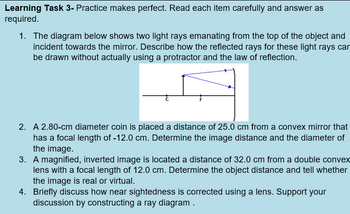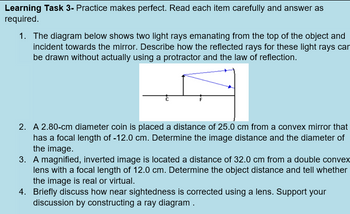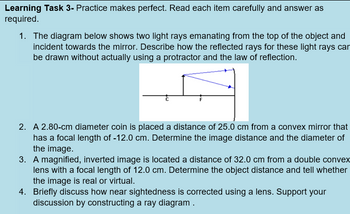The diagram below shows two light rays emanating from the top of the object and incident towards the mirror. Describe how the reflected rays for these light rays car be drawn without actually using a protractor and the law of reflection.
The diagram below shows two light rays emanating from the top of the object and incident towards the mirror. Describe how the reflected rays for these light rays car be drawn without actually using a protractor and the law of reflection.
Related questions
Question
100%

Transcribed Image Text:Learning Task 3- Practice makes perfect. Read each item carefully and answer as
required.
1. The diagram below shows two light rays emanating from the top of the object and
incident towards the mirror. Describe how the reflected rays for these light rays can
be drawn without actually using a protractor and the law of reflection.
2. A 2.80-cm diameter coin is placed a distance of 25.0 cm from a convex mirror that
has a focal length of -12.0 cm. Determine the image distance and the diameter of
the image.
3. A magnified, inverted image is located a distance of 32.0 cm from a double convex
lens with a focal length of 12.0 cm. Determine the object distance and tell whether
the image is real or virtual.
4. Briefly discuss how near sightedness is corrected using a lens. Support your
discussion by constructing a ray diagram.
Expert Solution
This question has been solved!
Explore an expertly crafted, step-by-step solution for a thorough understanding of key concepts.
Step by step
Solved in 2 steps with 1 images

Follow-up Questions
Read through expert solutions to related follow-up questions below.
Follow-up Question
Answer number 3

Transcribed Image Text:Learning Task 3- Practice makes perfect. Read each item carefully and answer as
required.
1. The diagram below shows two light rays emanating from the top of the object and
incident towards the mirror. Describe how the reflected rays for these light rays can
be drawn without actually using a protractor and the law of reflection.
2. A 2.80-cm diameter coin is placed a distance of 25.0 cm from a convex mirror that
has a focal length of -12.0 cm. Determine the image distance and the diameter of
the image.
3. A magnified, inverted image is located a distance of 32.0 cm from a double convex
lens with a focal length of 12.0 cm. Determine the object distance and tell whether
the image is real or virtual.
4. Briefly discuss how near sightedness is corrected using a lens. Support your
discussion by constructing a ray diagram.
Solution
Follow-up Question
can you answer number 2 and 3

Transcribed Image Text:Learning Task 3- Practice makes perfect. Read each item carefully and answer as
required.
1. The diagram below shows two light rays emanating from the top of the object and
incident towards the mirror. Describe how the reflected rays for these light rays can
be drawn without actually using a protractor and the law of reflection.
2. A 2.80-cm diameter coin is placed a distance of 25.0 cm from a convex mirror that
has a focal length of -12.0 cm. Determine the image distance and the diameter of
the image.
3. A magnified, inverted image is located a distance of 32.0 cm from a double convex
lens with a focal length of 12.0 cm. Determine the object distance and tell whether
the image is real or virtual.
4. Briefly discuss how near sightedness is corrected using a lens. Support your
discussion by constructing a ray diagram.
Solution
Follow-up Question
please answer number 2 and 3

Transcribed Image Text:Learning Task 3- Practice makes perfect. Read each item carefully and answer as
required.
1. The diagram below shows two light rays emanating from the top of the object and
incident towards the mirror. Describe how the reflected rays for these light rays can
be drawn without actually using a protractor and the law of reflection.
2. A 2.80-cm diameter coin is placed a distance of 25.0 cm from a convex mirror that
has a focal length of -12.0 cm. Determine the image distance and the diameter of
the image.
3. A magnified, inverted image is located a distance of 32.0 cm from a double convex
lens with a focal length of 12.0 cm. Determine the object distance and tell whether
the image is real or virtual.
4. Briefly discuss how near sightedness is corrected using a lens. Support your
discussion by constructing a ray diagram.
Solution